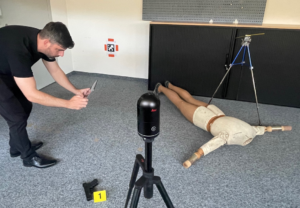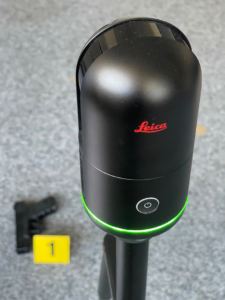Increasing case-clearing rates with better evidence-collection solutions
In “Forensic evidence and the police: the effects of scientific evidence on criminal investigations”, Peterson et al. (1984) found that using scientifically analysed evidence results in three times greater rate of case clearance of crime scenes compared to cases where such evidence was not used. On the other hand, Strom & Hickmann (2010) pointed to a worrisome underutilisation of forensic evidence in the vast majority of both solved and unsolved cases of assault, burglary, rape, and robbery incidents. The fact remains that only a tiny fraction of available forensic evidence present at scenes of serious crimes is actually utilised.
The reasons are complex and vary with the class of felony. Still, one thing is certain: technology which makes collecting evidence and systematically preserving the chain of custody easier and more reliable is a huge step in the right direction. Fortunately, Leica Geosystems’ laser scanning and measuring solutions provide a solid foundation for any investigation. After all, developing and proving a hypothesis about what happened depends on a robust account of the crime scene layout and the precise position of all the objects or items of interest.
To increase case clearance rates, investigators are looking for scene capture solutions that will allow them to gather positional and visual information while working under time pressure – quickly, accurately, and safely. And they want end-to-end solutions with minimal learning curves.
 Capturing the details of a mock crime scene with the BLK360 and forensic mapping software
Capturing the details of a mock crime scene with the BLK360 and forensic mapping software
Safer and sounder – working with a Forensic Digital Twin.
Leica Geosystems is addressing these needs with our Forensic Digital Twin solutions that capture every detail of a crime scene in minutes. The Forensic Digital Twin is a virtual representation of the entire scene that investigators can navigate in a 3D environment or even virtual reality to revisit the scene as the investigation progresses. This approach has many advantages. When hurrying around a crime scene, you are always in danger of missing important details or compromising crucial evidence. On the other hand, scanning a scene can be done in minutes allowing the investigating parties to create an immutable copy of the original state of the scene, which can then be revisited at will safely and effortlessly.
For these reasons, many in law enforcement are wondering how they can begin to adopt Forensic Digital Twin solutions into their standard procedures. Fortunately, Leica Geosystems’ next-generation imaging laser scanner, the BLK360, has made it even easier for investigators to start enjoying all the benefits of state-of-the-art crime scene investigation. At the touch of a button, every detail is documented in 3D for future re-examination in an immersive solution that ensures a seamless workflow all the way through to trial.
 BLK360 on a mock crime scene – blood spatter
BLK360 on a mock crime scene – blood spatter
Single-button 3D crime scene scanning
The new BLK360 is a simple solution that can be used by nearly everyone and lowers the barrier to using hi-tech for crime scene documentation. Anyone who can operate a tablet app can now reliably document a crime scene with high-resolution full-colour panoramic thermal and HDR images overlaid on a high-resolution 3D point cloud. It is the smallest and lightest imaging laser scanner of its kind and the easiest to operate.
At the push of a button, the device begins by capturing images of the crime scene using its four built-in cameras that take shots at five different exposure levels. This HDR technology means access to the visual evidence that used to get lost in the shadows or blown out in the highlights.
Once the BLK360 has captured a 360° set of photos, it automatically captures the scans. The new laser scanner captures 680,000 points per second, which is twice the speed of the first edition. But coupled with other improvements, the entire scan process is five times faster. It only takes 20 seconds to complete a full dome scan with images.
 BLK360 on a mock crime scene – evidence marker – weapon
BLK360 on a mock crime scene – evidence marker – weapon
All this power comes in a supremely portable device, which measures 155x80mm and weighs just 850g with batteries. That is very practical when moving the scanner around the location, but that is not the only convenience. The BLK360’s Visual Inertial System (VIS) automatically pre-registers scans on the scene, meaning that the VIS does the scan alignment and stitching of your scans automatically because it knows and sees where it is positioned relative to the previous scanning position.
Having VIS means you can immediately validate your data on the scene without needing to pause to manually align scans through Cyclone FIELD 360 and proceed to each subsequent scan with confidence. Besides the security provided by VIS registration, the coke-can-sized device offers high-speed USB-C and Wi-Fi transfer so that data is immediately available on your phone or tablet.
Overall, the entire process, from making initial settings in the Leica Cyclone FIELD 360 mobile-device app to capturing all your site scans by simply repositioning your tripod and then pressing a single button on the BLK360 to opening the registered image and point cloud data on your mobile device can be completed in around 15 mins. Investigators make the most of the BLK360 crime scene data with automatic registration, precise visual alignment, easy cleanup, and multiple visualisation and export options using Leica Cyclone REGISTER 360 software.
Summary
The BLK360, with the powerful Cyclone software, streamlines the reality capture process so effectively that any police officer or scene investigator can quickly and confidently document a small to medium-sized crime scene. Whether that leads to more convictions depends on other factors, but we can confidently say that the BLK360’s 4-millimetre accuracy means that your scans create a true “forensic digital twin” of a crime scene, including all the critical evidence digitised for eternity.
An accurate 3D scene capture gives the investigation parties, who usually work under tremendous time pressure, all the critical information. It lessens human error and saves time on repeated scene visits, which is often impractical or not even possible due to the deterioration of a scene. It also helps the various investigating parties align their efforts while moving through different investigation and trial phases. Simply put: laser scanners don’t lie.
Author: David M. Taylor
soundswrite.ch
Editor: Malgorzata Krol
Director Marketing – Public Safety & Forensics
Hexagon Geosystems














